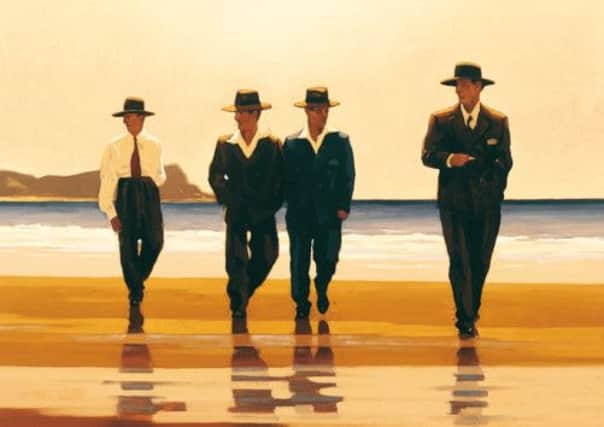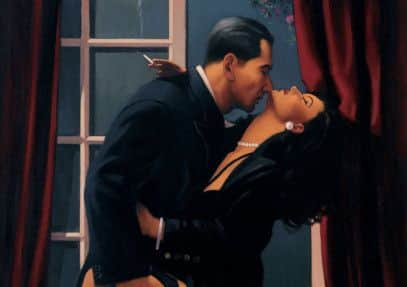Art review: Jack Vettriano, Glasgow


JACK VETTRIANO
Kelvingrove Art Gallery and Museum, Glasgow
Star rating: * *


Just across the River Clyde, the man himself was amongst friends and fans. He was celebrating his opening with hundreds of people in Kelvingrove, one of the country’s most magnificent museums. In the run-up to the show virtually every major media outlet in the UK had run an interview or feature. Like a politician or a Turner Prize winner, he had been interrogated on the Today programme by John Humphrys himself.
And yet weirdly, the myth has somehow persisted in public that Jack Vettriano, OBE, patronised by our own First Minister and purchased by such little-known chaps as one Alex Ferguson, apparently once a football manager of a club called Manchester United, was a poor soul. A man whose honest toil had been thwarted by a wicked cabal called “the art establishment”.
Advertisement
Hide AdThis is a self-taught man who has worked hard and been rewarded well. He has worked directly with commercial galleries since his first solo exhibition 21 years ago. His current exhibition catalogue contains an essay by one of this country’s most subtle and distinguished novelists, AL Kennedy. This is a man whose earliest work was shown in the Royal Scottish Academy and championed by the late Scottish critic, W Gordon Smith, who published his work in a broadsheet newspaper (Scotland on Sunday) and penned an essay for his first publication.
It is hard to stay sane in this topsy turvy world. To be honest, I would rather stay alone in any dark cupboard than spend more time contemplating Vettriano’s exhibition. For it is a miserable, soulless show, in which it’s hard to believe that anyone quite believes that the work deserves the hushed atmosphere, the spotlit old master presentation.
Whilst his success is self-evident, it is harder to make claims for Vettriano’s greatness, so the context for the exhibition is sensibly presented as biographical. This is Vettriano’s journey. Over 100 paintings have been sourced from private collections, many of them well known through reproduction, others little seen beyond their owners’ sitting rooms.
The quotes on the wall and the labels beside the paintings explain the artist’s inspiration in, or emotional affinity with, the work of Martin Scorsese or David Lynch, the lyrics of Leonard Cohen or Joni Mitchell. The contrast between such masters of complexity and the work on show hangs in the air sorrowfully.
I don’t really care that Vettriano can be a poor technical painter – I’m suspicious of virtuosity as an end in itself and there is something almost touching about the occasional passages of terrible paint in early work like The Billy Boys and the visible efforts to improve them, particularly in a couple of much stronger later self-portraits.
But we are all adults here (unaccompanied children are not admitted) and we do need to be able to say it out loud. In a work like The Singing Butler the information hangs on the surface. There is little joy in the handling. You sense teeth gritted in the execution. The movement of the paint on canvas does not suggest self-knowledge or skill or the embracing or abandonment of history – in other words, the authorship on which the best painting depends.
Advertisement
Hide AdVettriano has a strong sense of colour and a graphic grasp of two-dimensional space and these paintings portray a one-dimensional world. The word that most frequently comes to mind when viewing this exhibition is arrested. It is paint without painting, sex without consummation, a picnic or an alcoholic drink that is never swallowed.
Vettriano’s figures inhabit a weird, stalled, historical netherworld: flowered frocks and servants, fedoras, stockings and split skirts. It is the 1950s without poverty or sectarianism, the 1940s without the war. It is a world in which women have their mouths open to smoke or apply scarlet lipstick, but are entirely voiceless.
Advertisement
Hide AdThe women in many of the paintings, if that’s what they are, rather than scrapbook outlines of unusually uniform female forms, are frozen in odd pre-or post coital poses. They are not humans. A tit hangs out of a dress, but it doesn’t seem to be made of flesh. In a quote on the wall the artist tells us he is interested in “women,” they are his “subject”. It strikes me as a curious way to describe human beings.
Real sex is messy, it makes us vulnerable as much as powerful and it brings with it unexpected things: love, humiliation, power, embarrassment, compassion, and familial ties. There is no compassion here. While the females in Vettriano’s “erotic paintings”, embarrassingly corralled in a red-walled corridor, take off their clothes, spread their legs, raise their bottoms for the men in the pictures and are groped in the crotch, the male figures, whom we might suspect by the facial resemblance are occasionally the artist’s own avatar, never get their kit off either literally or emotionally.
This is image-making and exhibition-making that is dour and risk averse but it is also deeply unpleasant: a miserably reductive view of men and a dangerously crude view of women. It is horrible. I want no part of a world that declares it snobbery to say that out loud.
Kelvingrove rarely shows living artists, which is a terrible shame, when it has inspired so many of them. But showmanship is in the museum’s DNA. Tom Honeyman, its most successful director and the man who bought its famous Dali, is on film saying that he would have Celtic and Rangers playing in the gallery if he could. The basement gallery space recently showed Renaissance masterpieces, but it has also displayed Kylie Minogue’s hot pants. So the world of culture will not collapse.
But you can keep your Vettrianos. And above all, please do spare me the paranoid fantasy of powerful men, be they artists or audiences, that they are somehow locked out from culture. I’m tired of this particular charade. Turn out the light please. Leave me here alone in the dark.
• Until 23 February